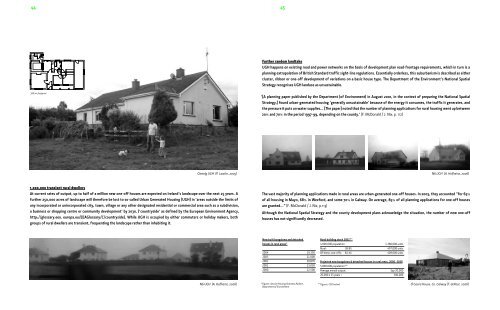Download Project PDF - Irish Architecture Foundation
Download Project PDF - Irish Architecture Foundation
Download Project PDF - Irish Architecture Foundation
Create successful ePaper yourself
Turn your PDF publications into a flip-book with our unique Google optimized e-Paper software.
44 45<br />
169 m 2 footprint<br />
1,000,000 transient rural dwellers<br />
At current rates of output, up to half of a million new one-off houses are expected on Ireland’s landscape over the next 25 years. A<br />
further 250,000 acres of landscape will therefore be lost to so-called Urban Generated Housing (UGH) in ‘areas outside the limits of<br />
any incorporated or unincorporated city, town, village or any other designated residential or commercial area such as a subdivision,<br />
a business or shopping centre or community development’ by 2030. (‘countryside’ as defined by the European Environment Agency,<br />
http://glossary.eea. europa.eu/EEAGlossary/C/countryside). While UGH is occupied by either commuters or holiday makers, both<br />
groups of rural dwellers are transient, frequenting the landscape rather than inhabiting it.<br />
Glenelg.UGH (P. Lawlor, 2005)<br />
Further random landtake<br />
UGH happens on existing road and power networks on the basis of development plan road-frontage requirements, which in turn is a<br />
planning extrapolation of British Standard traffic sight-line regulations. Essentially orderless, this suburbanism is described as either<br />
cluster, ribbon or one-off development of variations on a basic house type. The Department of the Environment’s National Spatial<br />
Strategy recognises UGH landuse as unsustainable.<br />
‘[A planning paper published by the Department (of Environment) in August 2001, in the context of preparing the National Spatial<br />
Strategy,] found urban-generated housing ‘generally unsustainable’ because of the energy it consumes, the traffic it generates, and<br />
the pressure it puts on water supplies… [The paper] noted that the number of planning applications for rural housing went up between<br />
20% and 70% in the period 1997-99, depending on the county.’ (F. McDonald / J. Nix, p. 112)<br />
The vast majority of planning applications made in rural areas are urban-generated one-off houses. In 2003, they accounted “for 65%<br />
of all housing in Mayo, 68% in Wexford, and some 70% in Galway. On average, 85% of all planning applications for one-off houses<br />
are granted…” (F. McDonald / J. Nix, p.113)<br />
Although the National Spatial Strategy and the county development plans acknowledge the situation, the number of new one-off<br />
houses has not significantly decreased.<br />
New built bungalows and detached<br />
houses in rural areas*<br />
2004 19,350<br />
2003 21,000<br />
2002 20,870<br />
2001 23,050<br />
2000 22,500<br />
Rural building stock 2002**<br />
4,000,000 population 1,280,000 units<br />
Rural: 38.8% 497,000 units<br />
Of these, one-offs: 82.4% 409,000 units<br />
<strong>Project</strong>ed new bungalows & detached houses in rural areas, 2006 -2030<br />
5,800,000 population**<br />
N6.UGH (A. Hofheinz, 2006) *Figures: Annual Housing Statistics Bulletin,<br />
**Figures: CSO Ireland<br />
Department of Environment<br />
Average annual output: Say 20,000<br />
20,000 x 25 years = 500,000<br />
N6.UGH (A. Hofheinz, 2006)<br />
Ó Gaora House, Co. Galway (T. dePaor, 2006)


